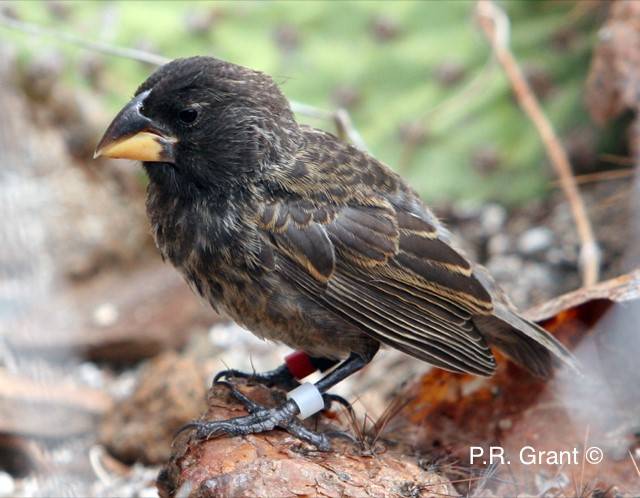Post by Infinity Blade on Nov 14, 2021 1:55:35 GMT 5
Big Bird lineage Finch

A member of the Big Bird lineage of finches on Daphne Major. Image by Peter R. Grant (link).
Temporal range: Holocene (present)
Conservation status: N/A
Scientific classification:
Life
Domain: Eukaryota
(unranked): Unikonta
(unranked): Opisthokonta
(unranked): Holozoa
(unranked): Filozoa
Kingdom: Animalia
Subkingdom: Eumetazoa
(unranked): Bilateria
Clade: Nephrozoa
Superphylum: Deuterostomia
Phylum: Chordata
Clade: Olfactores
Clade: Craniata
Subphylum: Vertebrata
Infraphylum: Gnathostomata
Clade: Eugnathostomata
Clade: Teleostomi
Superclass: Tetrapoda
Clade: Reptiliomorpha
Clade: Amniota
Clade: Reptilia
Clade: Eureptilia
Clade: Romeriida
Clade: Diapsida
Clade: Neodiapsida
Clade: Archelosauria
Clade: Archosauromorpha
Clade: Archosauriformes
Clade: Crurotarsi
Clade: Archosauria
Clade: Avemetatarsalia
Clade: Ornithodira
Clade: Dinosauromorpha
Clade: Dinosauriformes
Clade: Dinosauria
Order: Saurischia
Clade: Eusaurischia
Suborder: Theropoda
Clade: Neotheropoda
Clade: Averostra
Clade: Tetanurae
Clade: Orionides
Clade: Avetheropoda
Clade: Coelurosauria
Clade: Tyrannoraptora
Clade: Maniraptoriformes
Clade: Maniraptora
Clade: Pennaraptora
Clade: Paraves
Clade: Eumaniraptora
Clade: Averaptora
Clade: Avialae
Clade: Euavialae
Clade: Avebrevicauda
Clade: Pygostylia
Clade: Ornithothoraces
Clade: Euornithes
Clade: Orithuromorpha
Clade: Ornithurae
Clade: Neornithes
Infraclass: Neognathae
Clade: Eufalconimorphae
Clade: Psittacopasserae
Order: Passeriformes
Suborder: Passeri
Infraorder: Passerida
Superfamily: Emberizoidea
Family: Thraupidae
Genus: Geospiza
Species: G. conirostris x G. fortis
The Big Bird finch lineage (so named because they are notably large[1]) is a rapidly evolved, reproductively isolated lineage of finch endemic to the island of Daphne Major.
Evolution:
In 1981, an immature male finch immigrated to Daphne Major. Although it resembled a native species, G. fortis (the medium ground finch), it was 70% larger and sang a unique song. It was initially believed to be a G. scandens x G. fortis hybrid, and the survival and breeding of this male finch and its descendants was tracked over the next six generations (across 31 years). The male bred with a female G. fortis, as did one of its F1 offspring. However, all other breedings were endogamous (i.e. occurred within this lineage). By the second generation, the lineage behaved as an independent species from all others on the island.[1]
A phylogenetic tree analysis showed that the original foreign male was not a hybrid at all, but rather a G. conirostris, which is found on Española (an island over 100 km away) and its satellite Gardner (it is found nowhere else in the Galápagos).[1]
Despite inbreeding, the Big Bird finches showed high fitness, as indicated by their high survival and reproductive output. The lineage became reproductively isolated from all other finches on the island, likely due to large bill size, large body size, and its distinctive song.[1]
Description:
Big Bird finches are, on average, intermediate between the two parent species’ mean body sizes, but closer in size to G. fortis. However, they are closer to G. conirostris in bill size.[1]
References:
[1] Lamichhaney, S., Han, F., Webster, M. T., Andersson, L., Grant, B. R., & Grant, P. R. (2018). Rapid hybrid speciation in Darwin’s finches. Science, 359(6372), 224-228.

A member of the Big Bird lineage of finches on Daphne Major. Image by Peter R. Grant (link).
Temporal range: Holocene (present)
Conservation status: N/A
Scientific classification:
Life
Domain: Eukaryota
(unranked): Unikonta
(unranked): Opisthokonta
(unranked): Holozoa
(unranked): Filozoa
Kingdom: Animalia
Subkingdom: Eumetazoa
(unranked): Bilateria
Clade: Nephrozoa
Superphylum: Deuterostomia
Phylum: Chordata
Clade: Olfactores
Clade: Craniata
Subphylum: Vertebrata
Infraphylum: Gnathostomata
Clade: Eugnathostomata
Clade: Teleostomi
Superclass: Tetrapoda
Clade: Reptiliomorpha
Clade: Amniota
Clade: Reptilia
Clade: Eureptilia
Clade: Romeriida
Clade: Diapsida
Clade: Neodiapsida
Clade: Archelosauria
Clade: Archosauromorpha
Clade: Archosauriformes
Clade: Crurotarsi
Clade: Archosauria
Clade: Avemetatarsalia
Clade: Ornithodira
Clade: Dinosauromorpha
Clade: Dinosauriformes
Clade: Dinosauria
Order: Saurischia
Clade: Eusaurischia
Suborder: Theropoda
Clade: Neotheropoda
Clade: Averostra
Clade: Tetanurae
Clade: Orionides
Clade: Avetheropoda
Clade: Coelurosauria
Clade: Tyrannoraptora
Clade: Maniraptoriformes
Clade: Maniraptora
Clade: Pennaraptora
Clade: Paraves
Clade: Eumaniraptora
Clade: Averaptora
Clade: Avialae
Clade: Euavialae
Clade: Avebrevicauda
Clade: Pygostylia
Clade: Ornithothoraces
Clade: Euornithes
Clade: Orithuromorpha
Clade: Ornithurae
Clade: Neornithes
Infraclass: Neognathae
Clade: Eufalconimorphae
Clade: Psittacopasserae
Order: Passeriformes
Suborder: Passeri
Infraorder: Passerida
Superfamily: Emberizoidea
Family: Thraupidae
Genus: Geospiza
Species: G. conirostris x G. fortis
The Big Bird finch lineage (so named because they are notably large[1]) is a rapidly evolved, reproductively isolated lineage of finch endemic to the island of Daphne Major.
Evolution:
In 1981, an immature male finch immigrated to Daphne Major. Although it resembled a native species, G. fortis (the medium ground finch), it was 70% larger and sang a unique song. It was initially believed to be a G. scandens x G. fortis hybrid, and the survival and breeding of this male finch and its descendants was tracked over the next six generations (across 31 years). The male bred with a female G. fortis, as did one of its F1 offspring. However, all other breedings were endogamous (i.e. occurred within this lineage). By the second generation, the lineage behaved as an independent species from all others on the island.[1]
A phylogenetic tree analysis showed that the original foreign male was not a hybrid at all, but rather a G. conirostris, which is found on Española (an island over 100 km away) and its satellite Gardner (it is found nowhere else in the Galápagos).[1]
Despite inbreeding, the Big Bird finches showed high fitness, as indicated by their high survival and reproductive output. The lineage became reproductively isolated from all other finches on the island, likely due to large bill size, large body size, and its distinctive song.[1]
Description:
Big Bird finches are, on average, intermediate between the two parent species’ mean body sizes, but closer in size to G. fortis. However, they are closer to G. conirostris in bill size.[1]
References:
[1] Lamichhaney, S., Han, F., Webster, M. T., Andersson, L., Grant, B. R., & Grant, P. R. (2018). Rapid hybrid speciation in Darwin’s finches. Science, 359(6372), 224-228.



